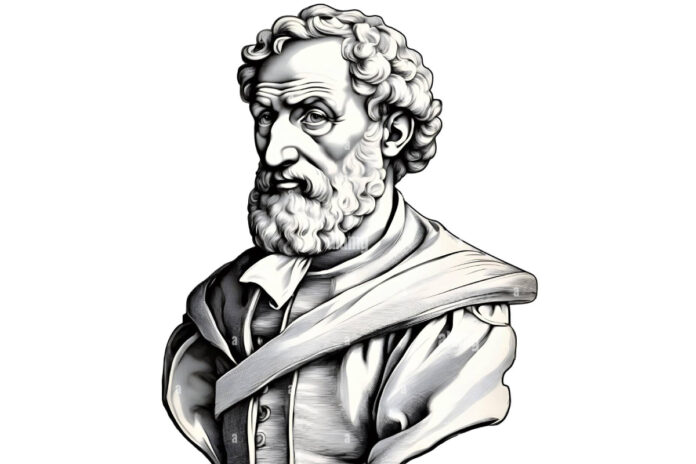Michelangelo Buonarroti, an epitome of Renaissance brilliance, remains one of history’s most revered artists. His unparalleled contributions to sculpture, painting, and architecture have etched his name permanently into the annals of art history. This article delves into the life, works, and legacy of Michelangelo, exploring his major achievements and the impact of his genius on the world.
Early Life and Education
Childhood and Early Influences
Michelangelo di Lodovico Buonarroti Simoni was born on March 6, 1475, in Caprese, a small town in the Republic of Florence. His family moved to Florence when he was still a child, and it was here that he would grow up and develop his extraordinary talents. Florence, a hub of Renaissance art and culture, provided the perfect environment for a budding artist.
Apprenticeship and Early Works
At the age of 13, Michelangelo was apprenticed to the painter Domenico Ghirlandaio, where he learned the basics of fresco painting. His talents quickly became apparent, and he moved on to study sculpture under the patronage of Lorenzo de’ Medici, the ruler of Florence. During this period, Michelangelo created several notable works, including the relief sculptures “Madonna of the Stairs” and “Battle of the Centaurs,” which showcased his precocious skill.
The Pinnacle of Sculpture
David: A Symbol of Renaissance Art
One of Michelangelo’s most iconic works is the statue of David, completed between 1501 and 1504. This colossal marble statue, standing at 17 feet tall, represents the biblical hero David who defeated Goliath. Unlike previous representations, Michelangelo’s David is depicted before the battle, embodying the ideals of youthful beauty and physical perfection. The statue was initially intended for the Florence Cathedral but was instead placed in the Piazza della Signoria, where it became a symbol of the Republic of Florence’s strength and independence.
The Pietà: A Masterpiece of Emotion
Another of Michelangelo’s significant sculptures is the Pietà, created between 1498 and 1499 and housed in St. Peter’s Basilica in Vatican City. This exquisite marble sculpture depicts the Virgin Mary cradling the dead body of Jesus. The Pietà is renowned for its intricate detail and the profound emotion it conveys. Michelangelo’s ability to infuse marble with such tenderness and sorrow set a new standard in sculpture.
The Genius of Painting
The Sistine Chapel Ceiling
In 1508, Michelangelo was commissioned by Pope Julius II to paint the ceiling of the Sistine Chapel. This monumental project, completed in 1512, covers approximately 12,000 square feet and includes over 300 figures. The ceiling’s central panels depict scenes from the Book of Genesis, including the iconic “Creation of Adam,” where God reaches out to touch Adam’s finger. Michelangelo’s use of dynamic figures and complex compositions transformed the ceiling into a masterpiece of High Renaissance art.
The Last Judgment
Later, between 1536 and 1541, Michelangelo returned to the Sistine Chapel to paint “The Last Judgment” on the altar wall. This fresco, filled with dramatic and intense figures, depicts the Second Coming of Christ and the final judgment of souls. The work’s powerful portrayal of divine justice and human frailty stirred both admiration and controversy due to its stark realism and the depiction of nude figures.
Architectural Brilliance
St. Peter’s Basilica
In addition to his accomplishments in sculpture and painting, Michelangelo made significant contributions to architecture. One of his most notable projects was the completion of St. Peter’s Basilica in Vatican City. Appointed chief architect in 1546, Michelangelo designed the basilica’s iconic dome, which remains one of the largest in the world. His innovative use of space and structural ingenuity ensured the basilica’s status as a masterpiece of Renaissance architecture.
Laurentian Library
Another significant architectural achievement was the Laurentian Library in Florence, commissioned by the Medici family. Michelangelo’s design for the library’s reading room and the elaborate entrance staircase are considered revolutionary. His use of contrasting architectural elements and the incorporation of sculpture into the design exemplified his innovative approach to architecture.
Legacy and Influence
Lasting Impact on Art
Michelangelo’s influence on art is immeasurable. His works have inspired countless artists and have been studied for centuries. His ability to capture the human form with such precision and emotion set new standards in art. The techniques he developed in sculpture, painting, and architecture became foundational principles for future generations.
Michelangelo’s Philosophy of Art
Beyond his technical skills, Michelangelo’s philosophy of art also left a profound legacy. He believed that art should be a reflection of divine beauty and truth, a principle that guided all his works. His dedication to perfection and his relentless pursuit of artistic excellence are evident in every piece he created.
Major Works of Michelangelo
Moses
Commissioned for the tomb of Pope Julius II, the statue of Moses is one of Michelangelo’s most powerful works. Completed around 1515, it depicts Moses with intense realism, holding the tablets of the Ten Commandments. The detailed rendering of muscles and veins, combined with the dynamic pose, showcases Michelangelo’s mastery of marble.
The Dying Slave and The Rebellious Slave
These two statues, created between 1513 and 1516, were intended for the tomb of Pope Julius II but were never completed. The Dying Slave and The Rebellious Slave exemplify Michelangelo’s ability to convey human emotion and struggle through the human form. These works highlight his exceptional talent in rendering the human body with lifelike precision.
The Medici Chapels
Commissioned by the Medici family, Michelangelo designed and sculpted the Medici Chapels in the Basilica of San Lorenzo in Florence. The chapels house the tombs of prominent Medici figures, and Michelangelo’s sculptures, including “Dawn,” “Dusk,” “Night,” and “Day,” adorn them. These allegorical figures represent the passage of time and the eternal struggle between life and death.
Michelangelo’s Artistic Techniques
Mastery of Marble
Michelangelo’s ability to sculpt marble is legendary. He believed that every block of marble contained a figure waiting to be released, and his task was to uncover it. His skill in carving intricate details, such as the veins on David’s hands or the delicate folds of fabric in the Pietà, demonstrates his unparalleled expertise.
Fresco Painting
In fresco painting, Michelangelo’s use of vibrant colors and dynamic compositions set his work apart. His ability to create a sense of depth and movement on flat surfaces was revolutionary. The Sistine Chapel ceiling, with its complex figures and dramatic scenes, remains a testament to his genius in this medium.
Michelangelo’s Personal Life
Challenges and Triumphs
Michelangelo’s personal life was marked by both triumphs and challenges. Despite his immense success, he faced numerous difficulties, including conflicts with patrons and financial struggles. His dedication to his art often led him to work tirelessly, sometimes to the detriment of his health.
Relationships and Correspondence
Michelangelo maintained close relationships with several contemporaries, including fellow artists and intellectuals. His extensive correspondence, particularly with his family, provides insight into his thoughts and emotions. These letters reveal a deeply passionate and dedicated artist, often torn between his commitments and personal aspirations.
The Final Years
Last Works
In his later years, Michelangelo continued to create, even as his health declined. One of his final sculptures, the “Rondanini Pietà,” begun in 1552 and left unfinished at his death in 1564, shows a markedly different style, reflecting a more introspective and personal approach.
Death and Legacy
Michelangelo passed away on February 18, 1564, in Rome, at the age of 88. He was buried in the Basilica of Santa Croce in Florence, a fitting resting place for a man who had given so much to the city. His legacy endures, with his works continuing to inspire and awe millions around the world.
FAQs
1. What are some of Michelangelo’s most famous works?
Michelangelo’s most famous works include the statue of David, the Pietà, the Sistine Chapel ceiling, and “The Last Judgment.”
2. How did Michelangelo influence the Renaissance?
Michelangelo’s innovative techniques in sculpture, painting, and architecture set new standards and greatly influenced the course of Renaissance art.
3. Where can Michelangelo’s works be seen today?
Michelangelo’s works can be seen in various locations, including the Galleria dell’Accademia in Florence, St. Peter’s Basilica in Vatican City, and the Sistine Chapel.
4. What was Michelangelo’s philosophy of art?
Michelangelo believed that art should reflect divine beauty and truth, guiding his relentless pursuit of perfection in his works.
5. How did Michelangelo’s personal life affect his work?
Michelangelo’s personal life, marked by challenges and triumphs, deeply influenced his work, reflecting his passionate and dedicated nature.
Conclusion
Michelangelo Buonarroti’s contributions to art and architecture are unparalleled. His sculptures, paintings, and architectural designs not only exemplify the pinnacle of Renaissance art but also continue to influence and inspire artists and admirers alike. His relentless pursuit of perfection, his innovative techniques, and his profound understanding of the human condition have cemented his place as one of the greatest artists of all time.
Michelangelo Buonarroti’s life and works remain a testament to the extraordinary heights of human creativity and artistic achievement. His legacy continues to inspire and captivate the world, ensuring that his genius will never be forgotten.

